Private Eston Allen Baxter
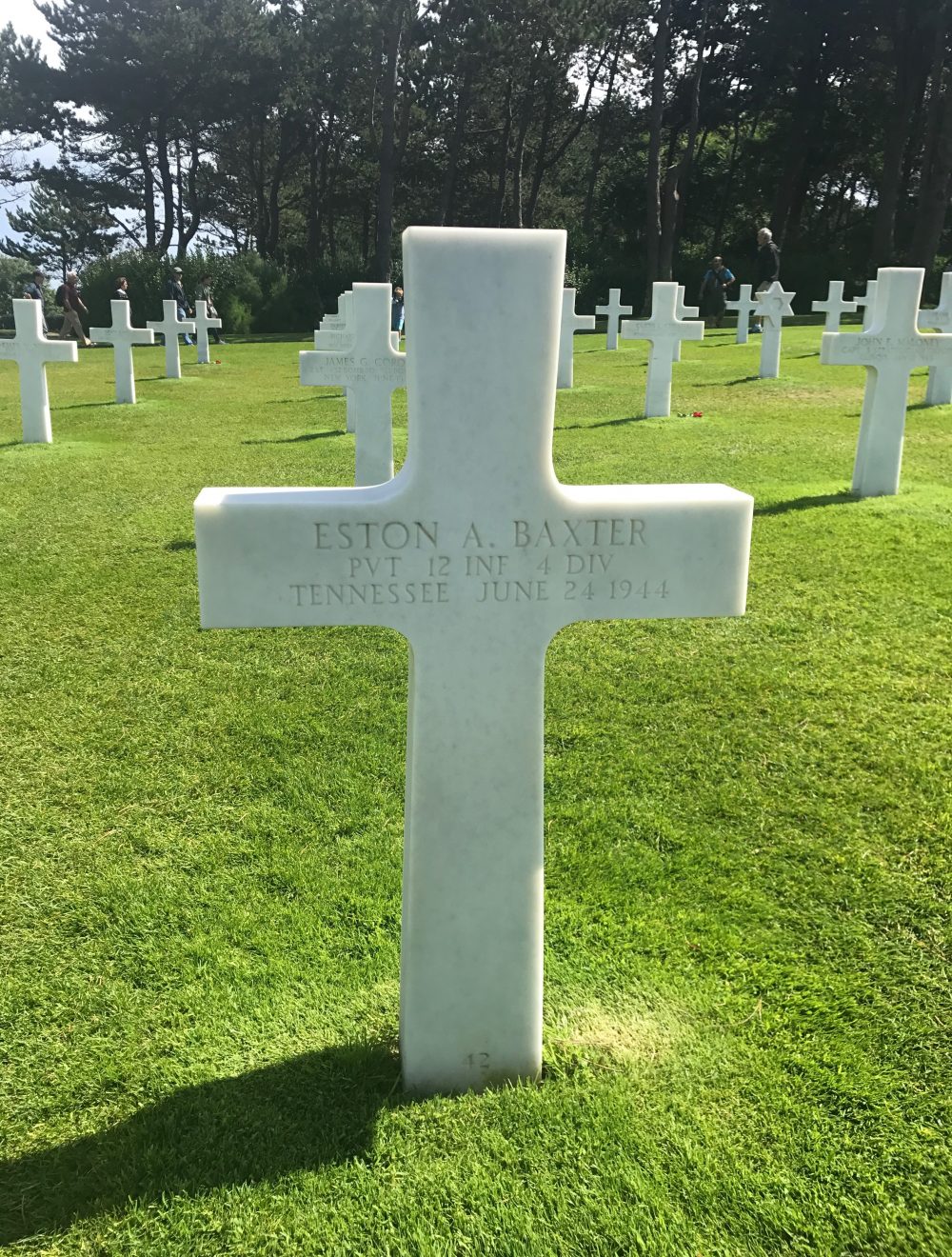
- Unit: 4th Infantry Division, 12th Infantry Regiment
- Service Number: 34490992
- Date of Birth: February 23, 1922
- Entered the Military: November 3, 1942
- Date of Death: June 24, 1944
- Hometown: Cosby, Tennessee
- Place of Death: near Digisville, France
- Award(s): Purple Heart
- Cemetery: Plot B, Row 6, Grave 42. Normandy American Cemetery, Colleville-sur-Mer, France
Mentored by Ms. Hillery Griffin
Cosby High School
2013-2014
Early Life
Eston Baxter was born on February 13, 1922, in Cosby, Tennessee, the firstborn of Edna Valentine and Jasper Allen Baxter. He had two younger brothers, Fred Greer Baxter, born in 1929, and Frank Baxter, born in 1935. His family worked as farmers. In 1930, they lived on his grandfather Green Valentine’s 75-acre farm.
Eston completed six years of school before leaving, probably to work on the farm. In 1940, Eston became the man of the house at age 18, following his father and grandfather’s deaths. His family lived on a new 70-acre farm on Caney Creek. Eston and his mother supported his siblings, 11-year-old Greer and 3-year-old Frank, and his 11-year-old cousin, Imogene, who lived with the family.
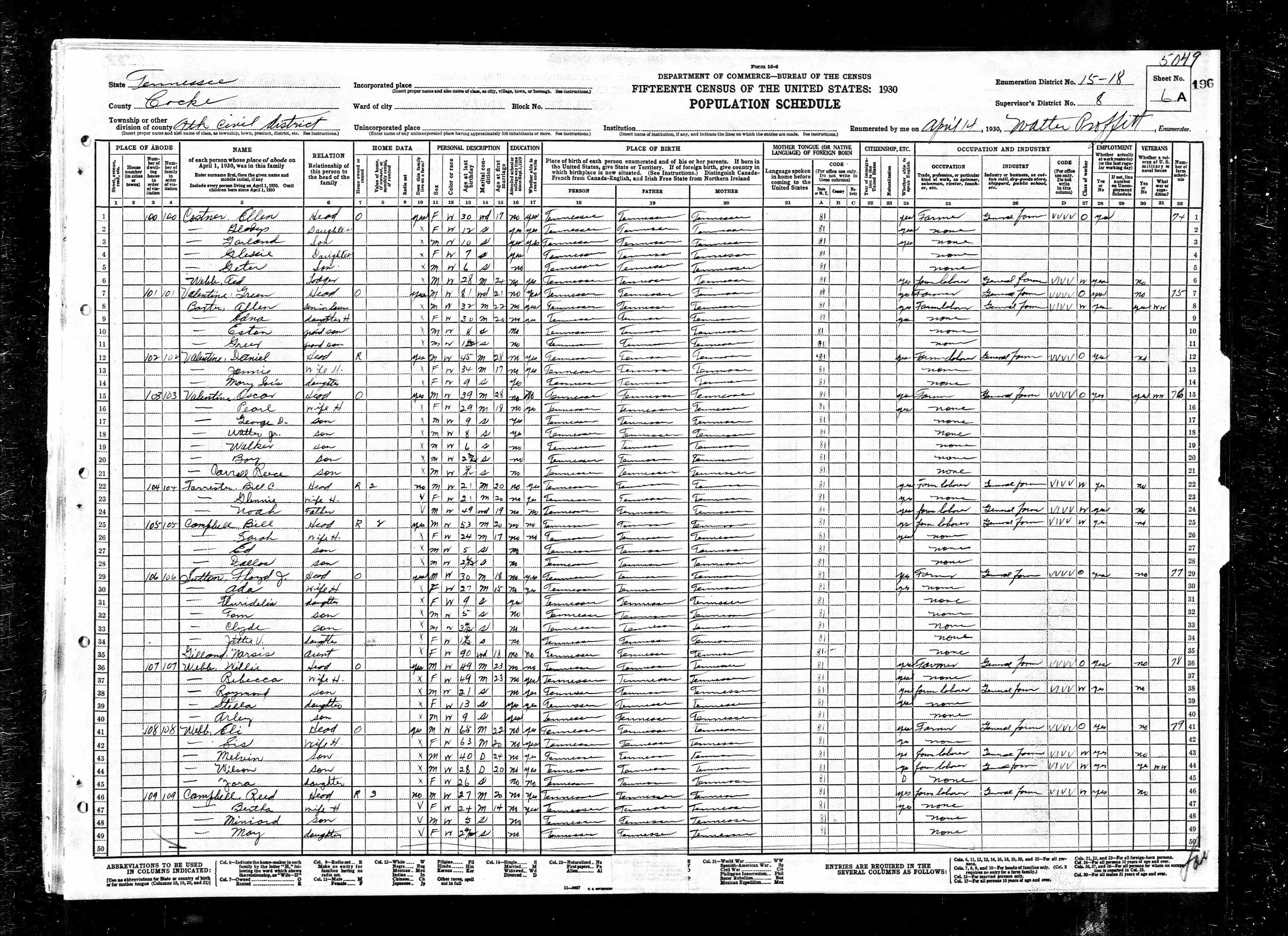


Homefront
Eston Baxter lived his entire life before the war in Cosby, Tennessee, in Cocke County.
Tennessee was busy during the war years. Oak Ridge became one of the main sites for the secret Manhattan Project. The enriched uranium produced here helped build the atomic bombs that ended the war.
Like most rural counties, Cocke County relied on agriculture to support itself. Farms covered most of the land. Livestock owners struggled with the ration system. If a farmer wanted to sell his hogs, he had to save up enough gas coupons to take them to slaughter. In the town of Newport, Bush’s and Stokely’s were two large employers, both in the canned food industry. Many Cocke County natives made illegal moonshine to support themselves. The rationing once again hampered their trade, as sugar is required to make moonshine.
Churches were incredibly supportive of the war. They would put up banners with stars on them, representing each soldier. If a boy died, his blue star would turn gold. When a boy returned home from war, he got to keep his star. Church bulletins had addresses, updates on soldiers, and even soldiers of the week. Cocke County had two movie theaters. They were the local hangouts, and many went just because of the chance to see a loved one on the newsreels.
Overall, the war broadened the small town’s horizons. Now they knew the names and locations of foreign locations and had reason to take an interest outside of local affairs.
Military Experience
Eston Baxter was drafted in 1942 into the 113th Infantry Regiment but transferred sometime between April and June 1944 to the 4th Infantry Division, 12th Infantry Regiment, 1st Battalion, B Company. It is not clear when he landed in the Normandy campaign (he may have arrived on D-Day or later as a reinforcement).
On the morning of June 6, 1944, the 4th Infantry Division landed on Utah Beach. They faced less enemy resistance than other beaches, and by noon, the 12th Infantry Regiment joined with the 8th and 22nd Infantry Regiments to push inland.
In the next few days, the 12th Infantry Regiment advanced inland, supported by reinforcements. They faced heavy attacks on June 7-8 for control of Azeville Road. They faced heavy attacks, including a counterattack in the afternoon of June 8 from a German bicycle unit carrying machine guns. For his leadership during the counterattack, Lieutenant Colonel Charles Jackson received a Distinguished Service Cross. They succeeded and advanced across the Montebourg-St. Floxel Road with the assistance of a tank battalion.
Reinforcements joined the 12th Infantry Regiment on June 12. They were able to capture Montebourg and were close to Valognes, a critical rail and road center of the Cotentin Peninsula. The unit regrouped and resupplied from June 13 to June 19. During this time, they conducted patrols and encountered a series of smaller engagements against the enemy. On June 19, they advanced under radio silence to take two hills that the Germans were using for artillery fire. The advance was costly – many officers were lost, and the medical station was hit.
At 7:30 a.m. on June 24, the 1st Battalion was paired with six tanks to take the high ground north of Digisville, France. Allied forces bombed the enemy strongpoints, causing casualties. The battalion paused to reorganize and became pinned down but was saved by the tanks. The 1st Battalion captured a German command post containing valuable documents. Company B took 225 Prisoners of War.
As they prepared for their next objective, a scouting party was hit by friendly fire. From the high ground, they saw vehicles fleeing into Cherbourg. By 9:40 p.m., they cut off the road and isolated the Germans defending an airfield from attack. During the night, the 1st Battalion seized several anti-aircraft guns, a searchlight, and ammunition. Company B captured an additional 395 prisoners.
Sometime during this day, Private Eston Baxter was hit and killed in action.
The 12th Infantry Regiment led the 4th Infantry Division march into Cherbourg. The port was captured and forced to turn toward Paris. A month later, the Baxter family received the telegram. His brother remembered that it was a Sunday and that their mother knew right away what the cars coming up the road meant because it was rare to see vehicles on that road.
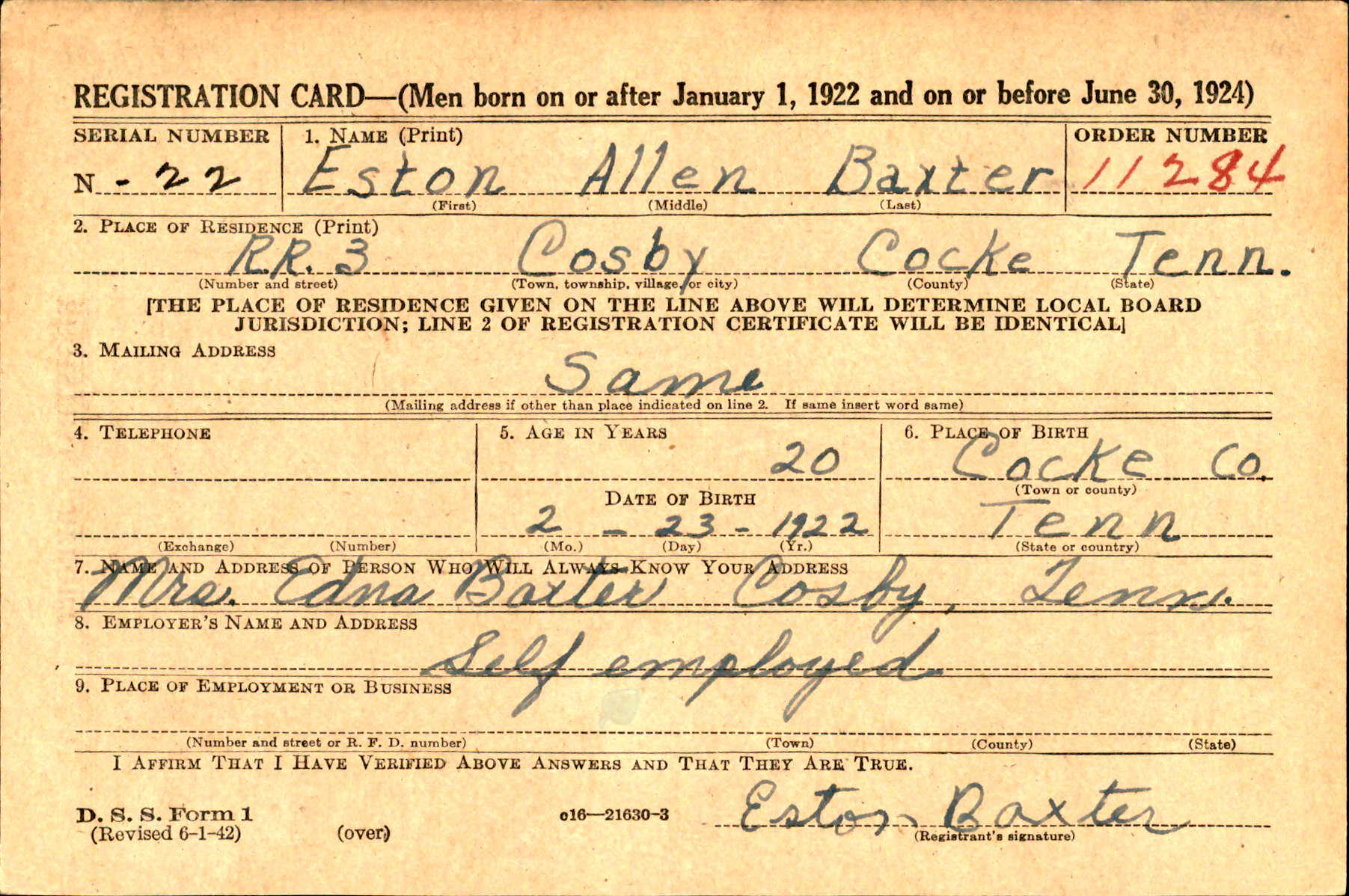
Eulogy
Some lives are quiet. So quiet, it seems that they never existed. I began to realize this when I researched the life of Private Eston A. Baxter. He lived on a small family farm in the sleepy town of Cosby, Tennessee. We share a hometown and a common ancestor.
His family didn’t have much money; his father died when Eston was only 17. Eston was forced to grow up prematurely to care for his elderly grandfather, his mother, two younger brothers, and a younger cousin. He was no stranger to hard work.
To his family’s dismay, he was drafted in 1942, and throughout his wartime experience, he wrote countless letters to his family. He wrote to his momma, to his little brother Frank-his little buddy-who, at age five, couldn’t even read yet, and to his many girlfriends back home-some of whom did not always write back. He told them how he was doing and asked if they were well. In one letter, he wrote of a man getting discharged. “I wish it was me, momma,” he wrote. He once asked his mother for money to get home on furlough, claiming he would hitchhike if he had to. He always signed his letters, “So answer soon,” which only reiterated that he longed to return to his small home in the mountains.
His last letter was written on June 17, 1944, from somewhere in France, and the next news his family received was a telegram announcing he had been killed in action. His little brother remembers the day well because “they all knew what the car in the driveway meant.”
Eston gave the ultimate sacrifice for his country, yet the memory of his life fades with time. His youngest brother was so small when Eston left for the war that he has very little memory of him. His niece only knew that her father encouraged her grandmother to leave his remains in France, buried amongst the men he served and died with during the war. While she never knew him personally, she enjoyed learning about his life along with us. You will not find his name in a history book, nor will you find the names of countless others who have died in the name of war. Today we honor a soldier buried in this cemetery to keep his memory alive for a little longer so that his legacy will not be buried with him.
To Eston, you have inspired me to push myself a little harder, to make the most of the time we do have. Life is not always; when the world needed them most, there were the men who answered the call. Each soldier not only bore the weight of his pack but the burden of sacrifice. These men are the reason we are standing here today. They enabled democracy to continue, and we must honor them by continually seeking to do better for the future.
William Faulkner wrote, “The past is not dead. It’s not even past.” This is closely reflected in the world the Normandy invasion made possible. Like Eston, most of the soldiers buried here led quiet lives, but the impact of their actions echoes loudly and shakes all who listen.
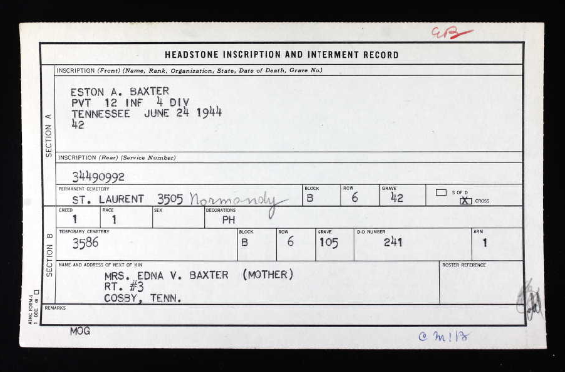
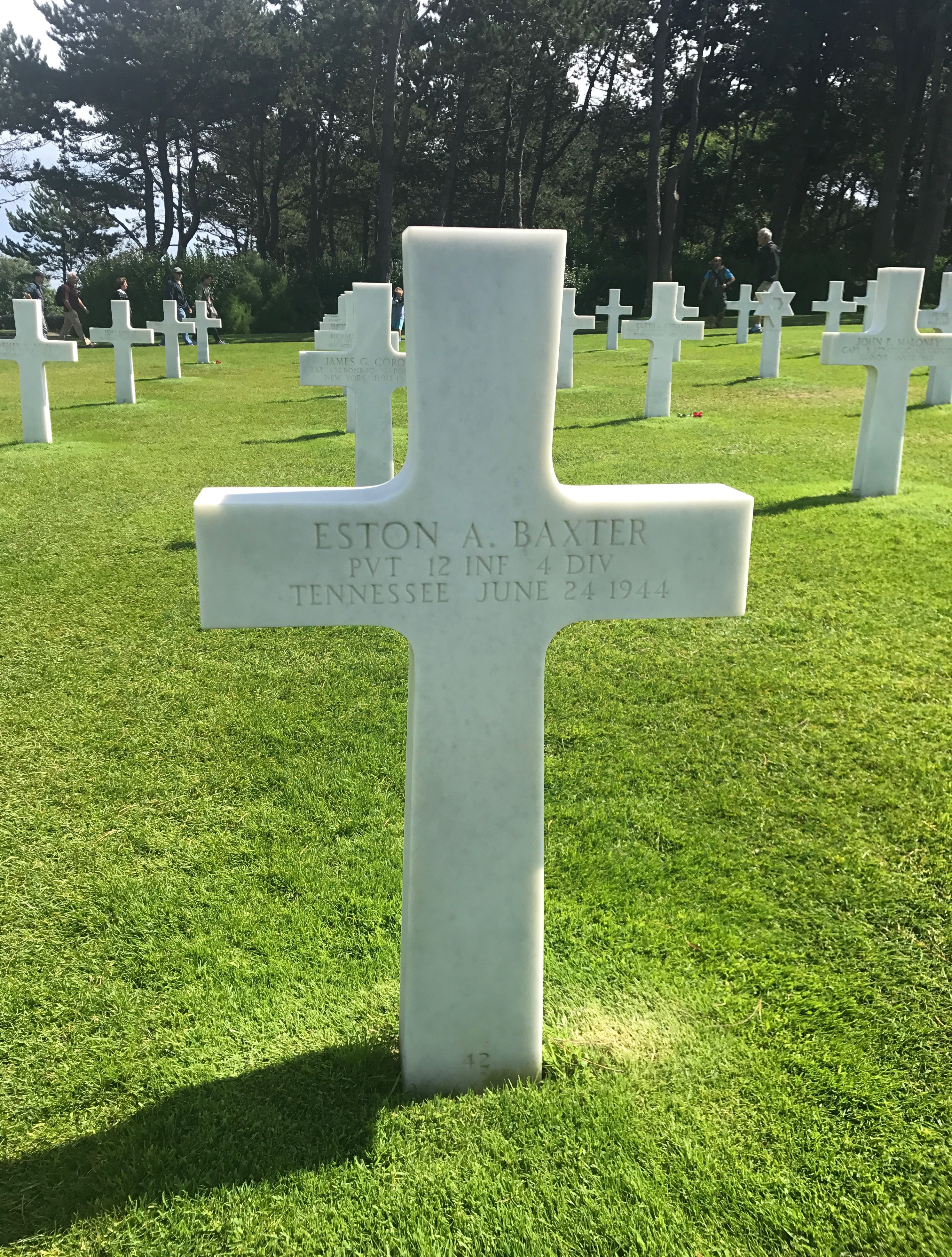
Bibliography
Primary Sources
Babcack, Bob. Email interview with author. March 4, 2014.
Baxter, Frank. Personal interview with author. May 20, 2014.
Eisenhower, Dwight D. Crusade in Europe. Baltimore: The Johns Hopkins University Press, 1997.
“Eston Baxter Is Killed In Action.” Newport Plain Talk, July 25, 1944.
Eston A. Baxter. Headstone and Interment Records for U.S. Military Cemeteries on Foreign Soil. Digital Images. ancestry.com.
Eston A. Baxter. World War II Army Enlistment Records, 1938-1946. ancestry.com.
Eston Allen Baxter. World War II Draft Cards, Young Men, 1940-1947. Digital Images. ancestry.com.
O’Neil, Duay. Personal interview with author. March 4, 2014.
Romeiser, John. Email interview with author. January 28, 2014.
Tennessee. Cocke County. 1930 U.S. Federal Census. Digital Images. ancestry.com.
Tennessee. Cocke County. 1940 U.S. Federal Census. Digital Images. ancestry.com.
Turner, Jane Anne Baxter. Telephone interview with author. March 4, 2014.
Secondary Sources
Gilbert, Martin. The Second World War: A Complete History. New York: Holt, 1989.
Johnson, Gerden. History of the Twelfth Infantry Regiment in World War II. National Fourth (Ivy) Division Association, 1948.
Kershaw, Alex. The Bedford Boys: One American Town’s Ultimate D-Day Sacrifice. Cambridge: Da Capo Press, 2003.
“Pvt Eston Allen Baxter.” Find a Grave. Updated August 8, 2010. Accessed February 19, 2021. www.findagrave.com/memorial/56642190/eston-allen-baxter.
Reporting World War II: American Journalism 1938-1946. New York: Library of America, 2001.
Roberts, Mary Louise. What Soldiers Do. Chicago: University of Chicago, 2013.
Stokesbury, James L. A Short History of World War II. New York: Harper, 1980.
Terkel, Studs. “The Good War:” An Oral History of World War II. New York: The New Press, 1984.
Wieviorka, Olivier. Normandy: The Landings to the Liberation of Paris. Cambridge: Harvard University, 2008.

